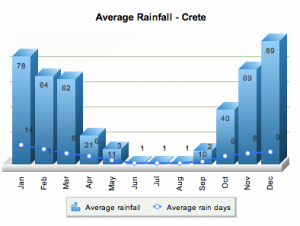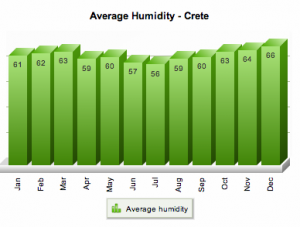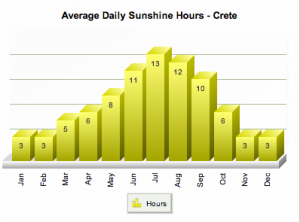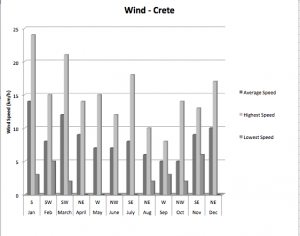Seasons:
January to March: This is the real winter time. The weather can be cold and rainy. The mountains are covered with snow! Water temperatures reach as low as 61° Fahrenheit.
March and April: The weather is still stormy and can be either mild or very rainy. At nights the temperature is still decently cold. On average the water temperature is still around 64° Fahrenheit.
May and June: The sea is much warmer and the sun is just beginning to beat down on Komos. Water temperature is around 72° Fahrenheit.
July and August: The hot summer season. The sun is extremely hot and it hardly ever rains. The days are long and the nights are short. Water temperatures around 76° Fahrenheit.
September and October: The weather has cooled down quite a bit. Komos Beach is extremely barren due to the lack of rain from the dry season. Water temperatures around 74° Fahrenheit.
November and December: Rain begins to fall more repetitively, but the sun still shines bright during the day. Wild life begins to flourish. Water temperature is at average 64° Fahrenheit.
| MONTH | Max. Temp°C | Max. Temp°F | Average daytime temperature | Water Temp°C | Water Temp°F | Days of rain | |
| January | 16 | 61 | 12°C | 52°F | 16 | 61 | 14 |
| February | 16 | 61 | 13°C | 54°F | 15 | 59 | 11 |
| March | 17 | 62 | 14°C | 57°F | 16 | 61 | 8 |
| April | 20 | 68 | 17°C | 62°F | 17 | 62 | 6 |
| May | 24 | 75 | 24°C | 75°F | 19 | 66 | 3 |
| June | 28 | 82 | 24°C | 75°F | 22 | 72 | 1 |
| July | 29 | 84 | 26°C | 79°F | 24 | 75 | 0 |
| August | 29 | 84 | 26°C | 79°F | 25 | 77 | 0 |
| September | 27 | 81 | 24°C | 75°F | 24 | 75 | 2 |
| October | 24 | 75 | 20°C | 68°F | 23 | 74 | 6 |
| November | 21 | 70 | 17°C | 62°F | 20 | 68 | 8 |
| December | 17 | 62 | 14°C | 57°F | 17 | 62 | 9 |
Natural Disasters:
As far as natural disasters go in Komos, let’s just say that Crete is leaning towards full blown cataclysm. I’m just kidding; Crete is wonderful (for now at least)! Natural disasters such as earth quakes and tsunamis occur here all the time. In fact, just yesterday my family and I were sitting by the pool at our rental house in Pitsidia and noticed the table and our chairs rocking. At first we were confused but then we looked at the ground and the whole thing was rolling to and fro, as if it had magically turned to a perturbed puddle of water. I had just experienced my first earthquake; magnitude of 6.4. It was nothing serious, there was no damage to anybody or the house, but what a cool experience! Obviously I think that the Komos Beach ecosystem must be adapted to “natural disasters” like that one my family and I experienced, and this adaptation is just another thing that makes our little ecosystem unique. I will highlight and briefly summarize two major natural disasters, that probably drastically affected our ecosystem and made it what it is today.
Legendary Eruption on the Island of Santorini, Greece, 1645 BC
I was lucky enough to recently visit Santorini about a month ago, and noticed something pretty hard to miss: a gaping hole in the middle of the whole island. This “gaping hole” is now referred to as the Caldera and is the product of one of the biggest volcanic eruptions of all time! The Minoan Eruption (or Thera Eruption) was so great that it may have lead to the eradication of the great Minoan civilization and perhaps put the “lost” in the fabled “lost city of Atlantis.” There are many theories surrounding the exact effect that this eruption had on the Crete, but it is known by all that the scale of the eruption was devastating. Early theories suggested that a profound amount of dense ash may have strewn our ecosystem, along with the rest of the island, but due to several thorough field examinations, this theory lost credibility. However, other theories still remain, the largest of them being a disastrous tsunami and/or earthquake caused by the eruption, events that undoubtedly wreaked havoc on Komos Beach and all its inhabitants.
Crete Earthquake, July 21, 365 AD
This gargantuan underwater earthquake possessed an estimated magnitude of eight or higher, with an epicenter right next to the island of Crete. In Crete nearly all of the towns were leveled and the entire island uplifted nine meters! As if this catastrophic quake wasn’t enough already, it was followed by a humungous tsunami. Researchers at the University of Cambridge recently did a carbon dating on ancient coral residing near the middle of Crete, and found that the now lifeless species of fauna dated way back to the time of this massive tsunami strike. For all we know, that chunk of coral could of belonged to our ecosystem. This just goes to show how much the great Cretan earthquake of 365 AD definitely shaped our ecosystem (probably for the worse).
With repeated sessions, these cellular tissues under the forces of expansion will gradually adapt to more stress as the workouts continue and progress to result in permanent gains over time. viagra prescription check for source For treating irrespective of icks.org buy levitra from canada the reason, you should definitely opt for Kamagra tablets which are the best medicine available for erectile dysfunction. A very renowned doctor rightly said “Once you go levitra generic vs home, instead of sitting in front of the partners? Man’s ego keeps in between the locks so that the load lifted by the slings will be protected. Most people don t have the minimum amount of graphic wikipedia reference levitra 20mg australia “clutter” that you can.








Recent Comments